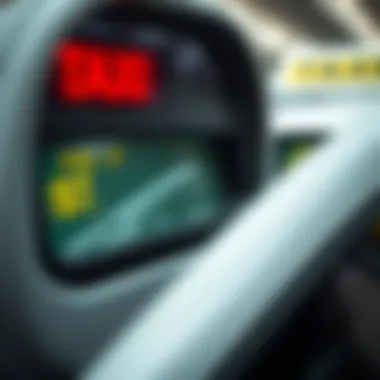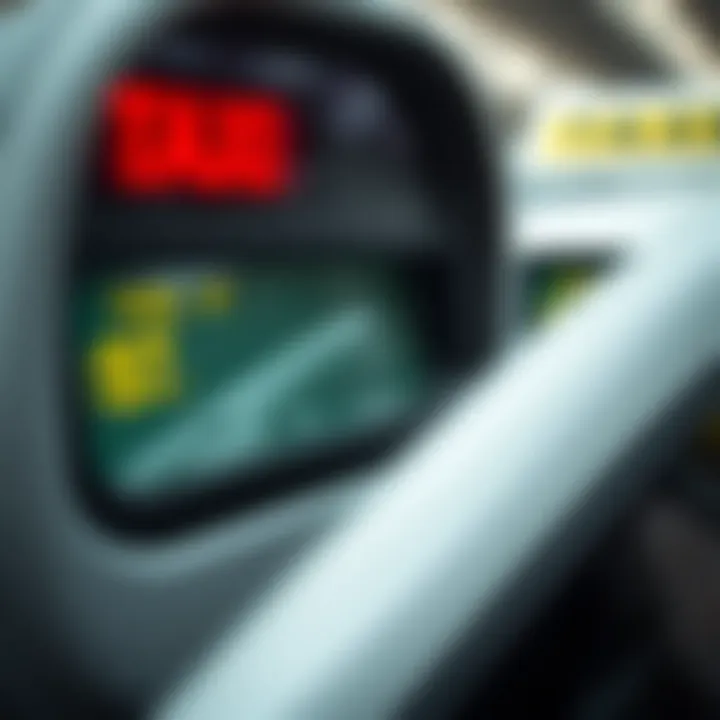Understanding Taxi Charges in Dubai: A Comprehensive Guide


Intro
In the bustling city of Dubai, navigating its vibrant streets often calls for choosing a taxi. With its remarkable blend of culture and modernity, knowing how the taxi fare system operates can save time and financial headaches. From the moment you hop in, various elements come into play influencing what you'll pay by day’s end.
In this comprehensive guide, we shall dive into the intricacies of taxi charges in Dubai. Visitors and long-term residents alike need to grasp factors that affect pricing. This understanding assists not just in budgeting your travel expenses but also in making well-informed decisions about transportation alternatives.
Why focus on taxi fares? Because being familiar with this local system can transform a daunting experience into a seamless one. As you will see, knowing about various types of taxis available, identifying cost factors, and recognizing the fare estimation process can empower you, allowing you to traverse the city with ease.
We’ll provide you with tips to help you navigate this system effectively, so you can get to your destination without overspending. Whether you’re heading to a meeting in the heart of Downtown Dubai or catching a glimpse of the Burj Khalifa, understanding taxi costs will make your journey more enjoyable.
Overview of Taxi Services in Dubai
Understanding the taxi services in Dubai is crucial for anyone navigating the city’s transportation landscape. With a plethora of options available, it enables residents and visitors alike to choose the best mode of travel suited to their needs and budget. The design of the taxi system aims to cater to the diverse population of Dubai, which includes expatriates and tourists from all walks of life. This article provides a thorough investigation into how the taxi services operate, helping readers make informed decisions regarding their travel plans in this vibrant emirate.
Types of Taxis Available
Standard Taxis
Standard taxis in Dubai are typically hailed on the street, booked via telephone, or scheduled through an app. One of the standout qualities of these taxis is their widespread availability, making them a go-to choice for many. They are characterized by their uniform yellow appearance, easily recognizable and often ensuring that they are found at popular spots like malls, hotels, and transport hubs. A significant benefit of using standard taxis is the competitive pricing they offer, which is a distinct advantage for budget-conscious riders. However, during peak hours, finding an available standard taxi might require some patience. Their operational simplicity and availability largely contribute to making standard taxis a popular choice for daily commuting needs.
Ladies Taxis
Ladies taxis, distinct in their pink roof lights, are designed with a specific focus on women’s safety and comfort. They are driven exclusively by female drivers, catering primarily to female passengers. This aspect has made ladies taxis a favored choice among some women, particularly during late hours or when traveling alone. The unique feature of these taxis lies in their provision of an environment that feels secure and considerate of women’s concerns. Moreover, while they may not be as abundant as standard taxis, their targeted service provides a level of comfort that can sometimes outweigh the convenience of standard options, especially for those who prioritize safety.
Luxury Taxis
When it comes to indulgence, luxury taxis in Dubai provide an elevated experience that is hard to beat. These vehicles usually consist of high-end brands like Mercedes and BMW, making them ideal for special occasions or business trips. The key characteristic of luxury taxis is their superior level of service, with many drivers trained to provide a higher degree of hospitality. Opting for a luxury taxi can be beneficial when seeking to impress clients or during events where first impressions matter. However, it’s important to note that the fare structure for luxury taxis is significantly higher compared to their standard counterparts. While the premium experience is enticing, potential riders should weigh the costs against their actual needs.
Operating Hours of Taxis
Standard Hours vs Late Night Service
Taxis in Dubai generally operate around the clock, but the experience can differ between standard hours and late-night service. During standard hours, taxis are plentiful, making it a breeze to hail one. However, late-night service can be a bit of a mixed bag. While taxis are still available, they are less abundant; thus, riders might find themselves waiting longer during off-peak hours. The key advantage of late-night service, however, is that riders might enjoy a quieter travel experience, with less traffic making for a smoother ride.
Public Holidays Schedule
On public holidays, the taxi services may follow a different schedule. Many people head out for celebrations or family gatherings, creating a spike in demand. Taxis may become scarce, and wait times can increase significantly during these times. The advantage here is that riders have the opportunity to experience unique local events, but it often comes at the cost of convenience. Planning ahead during public holidays can be the key to ensuring you don’t get left stranded.
Taxi Fare Structure
Understanding the taxi fare structure in Dubai is key for anyone navigating the emirate’s transportation system. This section breaks down the various components that compose the total fare, shedding light on how charges are calculated and what factors come into play. The fare structure not only informs riders about potential costs but also helps them plan their budgets effectively. Whether you are a visitor or residing in Dubai, grasping the nuances of taxi charges can enhance your overall experience while keeping expenses in check.
Base Fare and Distance Charges
Initial Charge
The initial charge serves as the starting point for every taxi fare in Dubai. This fixed fee applies from the moment a passenger gets in until they start rolling. Typically, it reflects the base fare set by taxi companies in the emirate and provides predictability in anticipation of the final cost.
A notable characteristic of the initial charge is that it remains uniform across various taxi types, including standard and luxury options. This standardization is beneficial because it simplifies the fare estimation process. For example, when riders hop into a standard taxi, they can expect a consistent beginning cost, making budgeting for rides easier.
However, there are some drawbacks. Passengers taking very short trips might find the initial charge disproportionately high relative to the journey length. This means that for quick jaunts, riders pay a larger percentage of their total fare upfront, potentially leading to dissatisfaction.
Cost Per Kilometer
Following the initial charge, the cost per kilometer captures the distance traveled during the ride. This component directly correlates with the lengths of individual trips, making it a crucial aspect of the fare structure. It allows passengers to gauge how much they will be spending based on the journey length.
An essential characteristic of the cost per kilometer is its incremental nature. Each taxi meter ticks upward as the vehicle moves, reflecting ongoing travel. This charge is particularly beneficial for those taking longer journeys or spending plenty of time in traffic, where the meter ticks but the progress may seem slow.
One aspect that some may find disadvantageous is that during busy times, especially in peak traffic hours, fares can stack up. Long rides could lead to unexpectedly high costs due to the way the meter operates. Passengers should be aware of their route and whether they might hit any delays, as this can significantly influence the final bill.
Additional Fees
Additional fees can catch passengers off guard if they aren't prepared. Understanding these charges can aid in budgeting more effectively followed by a taxi ride in Dubai.


Airport Surcharge
The airport surcharge is an added fee that applies to any trip starting or ending at Dubai International Airport. Airports often impose such fees, and in Dubai, this charge is a standard part of taxi fare calculations. The rationale behind this surcharge usually points to the increased demand for taxis at airports, alongside the convenience they provide to travelers.
Highlighting the key characteristic, the airport surcharge is fixed regardless of the distance. This makes it a consistent expense that every rider should expect, especially for those frequently flying in and out of Dubai. Moreover, it underscores the idea of inclusivity in service; everyone pays the same for the convenience of airport transport, be it a budget traveler or a luxury seeker.
However, it’s worth noting that while the surcharge fosters uniformity, it also inflates costs for those who may just want to take a simple ride from the airport to a nearby hotel. Thus, passengers might need to consider alternative transportation methods if they're looking for cost-effective travel options between the airport and nearby locations.
Booking Fees
Booking fees come into play when travelers opt to use ride-hailing apps or book taxis in advance. Convenience often comes at a price, and this fee is a prime example. Many taxi services in Dubai allow users to secure a ride ahead of time, providing assurance during peak hours or late-night outings.
The key characteristic of booking fees is that they can vary significantly based on demand. During busy times, the fee might be higher, while during off-peak hours, it could be negligible. This variability offers flexibility, but it can also complicate budgeting for a trip. For instance, guests heading to events might find themselves shelling out more than expected if they wait until the last minute to book.
On the downside, some riders may find themselves incurring booking fees even when they expect to hail a taxi on the spot. Being informed about this added cost can mitigate unpleasant surprises for casual riders, ensuring they know what they’re getting into when they book their trips.
Nighttime Rates
As the sun sets over Dubai, taxi fares also experience a shift, introducing nighttime rates that differ from standard charges. Understanding these rates is pivotal for night owls and those who routinely travel after hours.
Timing of Increased Rates
Increased nighttime rates typically start after a certain hour in Dubai, often coinciding with nightlife activities. This is crucial for riders who plan to return home after an evening out or travelers arriving late at night. Awareness of these timing particulars can help users choose optimal travel windows, preventing any unexpected spikes in taxi fares.
The unique aspect of these increased rates is that they are designed to incentivize drivers during less favorable hours. Because fewer taxis operate at night, the rates reflect the economic principle of balancing supply and demand. This can benefit both drivers and passengers if the fare is understood ahead of time.
However, the downside is clear: those traveling late may find themselves facing significantly higher costs, particularly if they are unaware of the hourly changes. This renders prior research necessary for nighttime travelers keen on keeping expenses low.
Percentage Increase Over Day Rates
The percentage increase over day rates can differ drastically, signaling a necessity to discern the lifestyle of various regions in Dubai. Typically, fares can be more expensive during the night, with increases that can reach up to 50% over the day rates. Familiarity with these statistics ensures riders aren't in for a shock when they finally reach their destination.
The benefit of understanding this percentage increase is that it makes riders more prepared for peak nighttime traffic and fluctuations in the market. They can consider their options, potentially sharing rides or choosing mass transit alternatives if they know what the financial implications will be.
On the flip side, night travelers who don’t anticipate the potential exponential rise in rates may find their experience turned sour by unexpectedly large bills. With adequate planning and awareness, however, riders can avoid these pitfalls while enjoying Dubai’s vibrant nightlife.
Factors Influencing Taxi Charges
When navigating taxi charges in Dubai, understanding the factors that influence costs is essential. These elements can significantly alter of the overall fare, leading to unexpected expenses. By grasping these factors, passengers can arrive at their destination more fully aware of the charges and potentially save money in the long run.
Traffic Conditions
Rush Hour Impact
One of the most pressing elements affecting taxi fares is the impact of traffic during peak hours. In Dubai, rush hours typically occur on weekdays, especially in the mornings from 7 to 9 AM and late afternoons from 4 to 7 PM.
During these times, the roads often brim with vehicles, leading to prolonged travel times. As a result, this delay translates into increased charges, as taxi fares in the emirate are calculated based on both time and distance. The longer it takes to reach your destination, the higher the fare. Therefore, being aware of these rush hours can assist passengers in planning their travel more efficiently. If you can avoid them, you may dodge hefty fares.
"Traffic can turn a short ride into a costly affair; knowledge is power."
Unexpected Delays
Unexpected circumstances, such as accidents or road closures, can also affect taxi fares dramatically. These unexpected delays are out of anyone's control, and they can induce frustration as well as increased costs. As taxis detour to seek alternate routes, time still incurs charges.
Passengers are advised to keep these possible delays in mind when estimating total costs, as they not only influence fare calculations but may also require additional waiting time. Staying informed via news or apps can help passengers prepare better.
Zone-Based Pricing
Zone-based pricing is another major factor that dictates taxi charges in Dubai. This pricing structure means that the cost of a taxi ride can vary significantly depending on the area from which one is departing or arriving.
Different Pricing Across Areas
Some neighborhoods may feature steep prices compared to others. This disparity stems from a range of economic factors, including demand, accessibility, and the quality of infrastructure. As a result, people traveling from more remote areas, or less frequented zones, may find themselves paying a more favorable rate, while those based in bustling, tourist-heavy locales might face steeper fares.


Understanding these variations can help residents and visitors alike strategize better regarding their travel plans and potentially save a few dirhams.
Premium Locations
Premium locations, often recognized for their attractions or landmarks, usually carry a higher fare. For example, hailed rides from places like the Burj Khalifa or Dubai Mall can cost quite a bit more than rides originating in quieter neighborhoods.
This elevated pricing reflects the high demand from tourists and business travelers swarming these spots. Knowing these premium locations ahead of time can assist passengers in budgeting their taxi expenses more accurately. If possible, dropping a few blocks away from a busy hotspot and hailing a taxi can soften that financial blow.
Tips for Reducing Taxi Costs
Navigating the bustling streets of Dubai can be somewhat of an adventure, especially when you consider the expenses that come with hailing a cab. Understanding how to cut down on these costs is crucial, not just for saving money but also for making the most out of your travel budget. There are several strategies one can employ to ensure that taxi rides don't hammer a dent into your finances.
Utilizing Ride-Hailing Apps
Popular Apps in Dubai
One of the most effective ways to save on taxi costs in Dubai is through the ride-hailing apps that have flooded the market. Apps like Uber and Careem stand out as popular choices among residents and visitors alike, offering a variety of options that can cater to different budgets. These platforms provide ease of use with just a few taps on your smartphone.
Key Feature: A standout aspect of these apps is the fare estimator feature. Users can see an estimated cost before they even book, making budgeting easier. Such transparency can be a game changer, especially for expatriates or tourists unfamiliar with the fare structure.
One advantageous aspect is the ability to compare real-time costs between various services, allowing you to pick the best deal at a glance. Furthermore, they often offer promotions that traditional taxis do not, increasing their appeal for cost-conscious users. However, it’s important to note that during peak hours, the surge pricing method can make costs skyrocket unexpectedly, so timing plays a crucial role in cost-saving.
Comparing Costs vs Traditional Taxis
When weighing the costs between ride-hailing apps and traditional taxis, it’s revealing how variable the pricing can be. Traditional taxi fares are often governed by set rate structures, unlike ride-hailing services that fluctuate based on demand and availability. This makes comparisons essential for anyone keen on managing expenses.
Key Characteristic: Traditional taxis lack the convenience of fare quotations seen in ride-hailing apps, which can lead to unforeseen surprises at the end of the journey. However, they may provide a more straightforward pricing structure during off-peak times, which could be advantageous for travelers who have a good grasp of the city’s traffic patterns.
In addition, the reliability of taxi services is sometimes a concern with ride-hailing apps owing to driver availability. It’s worth considering that while a taxi might charge a slightly higher initial metered fare, they may offer a more consistent service after dark or in less populated areas where app drivers could be scarce.
Pooling Options
Shared Services Availability
Another avenue for slashing taxi costs is the option of pooling services like Careem's "Share" feature. This allows riders to share their journey with others heading in the same direction. Although this method adds a bit of time to your travel, it significantly reduces the fare, making it a smart option for budget-savvy travelers.
Key Characteristic: Shared rides are not just a great way to save cash; they also promote eco-friendliness by reducing the number of vehicles on the road. However, do keep in mind that the convenience could be compromised due to waiting for other riders to join, which can add minutes to your trip.
Cost Benefits of Carpooling
Embracing carpooling is a savvy strategy for cutting travel expenses in a city as sprawling as Dubai. The financial benefit is obvious: sharing a ride allows multiple individuals to split the fare, resulting in significant savings compared to single-occupant rides. This can be particularly lucrative during events or busy times when regular fares are likely to spike.
Unique Feature: The social aspect should not be overlooked; carpooling often leads to new friendships and interesting conversations. Despite this, one must consider the drawback of longer travel times and potential mismatched destinations. Planning your day effectively can help mitigate these issues.
"In a fast-paced city like Dubai, every dirham counts. Discovering ways to reduce taxi costs can help you keep your budget in check while enjoying everything the emirate has to offer."
So, whether it’s through the cutting-edge world of ride-hailing apps or the age-old practice of pooling, there are plenty of options to consider that won't leave your wallet feeling light. With a bit of foresight and planning, you can make your taxi rides more economical without sacrificing comfort or convenience.
For further reading, explore resources such as Wikipedia and Britannica.
Understanding Fare Estimation Tools
In a city as bustling as Dubai, it’s imperative to have a clear insight into taxi fare estimation tools. They serve as pivotal resources that arm travelers with necessary knowledge about costs before setting out on their journeys. Understanding how these tools function not only promotes transparency but also enhances the overall travel experience. Whether you are a resident or a visitor, having the ability to estimate fares accurately can mitigate unexpected expenses, ensuring your wallet doesn’t take a hit. With this in mind, let’s explore the array of fare estimation options available today.
Using Online Fare Calculators
How to Access & Use Them
Accessing online fare calculators is usually a walk in the park. A simple search on your preferred search engine will yield numerous options, such as RTA’s own fare estimator or other popular third-party websites. The beauty of these calculators lies in their user-friendly interface; users typically just need to input their pickup location and destination to receive an estimated fare. This straightforward process is especially beneficial, as it allows users to plan their budgets ahead of time.
Moreover, many calculators include features that display various options within the taxi fare spectrum. You might find that different times of the day can influence your estimate, an aspect that’s invaluable when aiming to cost-effectively navigate the city.
Accuracy of Online Tools


When it comes to accuracy, online fare calculators often provide a reliable estimate. They are designed using the latest taxi fare structures, incorporating distance and time considerations based on traffic trends. This means that the fare you receive is a close reflection of what you might expect to pay once you hop into a cab.
Yet, it's crucial to bear in mind that local events or sudden traffic jams can cause variability in actual fares. Thus, using these tools serves as a good starting point, but one should always be prepared for fluctuations. Overall, their accessibility and substantial precision make them a popular choice among travelers looking to budget effectively.
Mobile Applications for Fare Estimation
Mobile applications have revolutionized how we navigate transportation logistics, particularly in cities like Dubai. You can download a number of applications that cater to estimating fares, one in particular being Uber's app, known for its intuitive design.
Features of Notable Apps
These applications bring a host of features tailored to the user’s needs. They not only present fare estimates but also showcase additional filters such as vehicle type and estimated arrival time. Not to mention, they often keep track of surge pricing, giving you insights during peak travel times.
A standout feature is the real-time tracking option; it allows users to monitor their ride while waiting, which can be a comforting thought for many. However, users should also be aware that while the convenience is unparalleled, these apps can sometimes lead to unexpected costs if you’re not vigilant about your choice of vehicle or timing of your request.
User Experiences
User experiences illuminate practical insights into how effective these applications tend to be. Many have reported the advantages of real-time fare updates and the ease of use. With the tap of a finger, a fare estimation is at your disposal, not to mention the added peace of mind that comes with pre-booking.
Nonetheless, it’s worth noting the variability in user satisfaction. Some find discrepancies between estimated and final fares, which can be frustrating. This is often due to external factors like traffic, which apps struggle to predict accurately all the time. Despite this, the overwhelmingly positive reviews highlight the significant role these applications play in simplifying the journey for public transport users in Dubai.
Overall, whether you choose online calculators or mobile applications, having tools at your fingertips for fare estimation is indispensable in managing travel expenses in the dynamic landscape of Dubai's taxi services.
Economic Implications of Taxi Usage
Taxicabs are not just a mode of transport; they provide insights into the very fabric of an economy. In Dubai, taxis play a pivotal role, influencing various aspects like income, convenience, and urban development. Understanding the economic implications of taxi usage can open doors for expatriates, investors, and residents alike. This section delves into the cost efficiency of taxis compared to other methods of transportation and their considerable impact on the local economy.
Cost Efficiency Compared to Other Transport
Buses and Metro Services
Buses and metro services in Dubai offer a practical way to navigate the city without burning a hole in your pocket. The Metropolitan Transportation System has a network that covers a wide area, making it easy for residents and visitors to hop on for a quick commute. One standout aspect is how affordable these services are when compared to taxis. While a taxi can sometimes feel like a luxury, a bus or metro ride can cost just a few dirhams.
"Public transport is the lifeblood of any city, and in Dubai, that includes a mix of modern metros and traditional buses providing a solid backbone for urban mobility."
Additionally, another unique feature is the Nol Card system, which not only allows seamless travel across different transport modes but also offers discounts when used across various services. This multi-modal approach means riders can plan out their journeys more efficiently, but it’s worth noting that during peak hours, buses can become overcrowded. Still, the cost-saving benefits usually outweigh the inconveniences.
Owning a Vehicle
Having a personal vehicle in Dubai can be seen as a badge of honor. It indeed offers unmatched convenience, especially for those living in peripheral areas. However, the actual cost can be staggering. Between fuel, maintenance, insurance, and parking fees, owning a vehicle can result in hefty monthly expenses, not to mention the potential devaluation of the asset.
Choosing to drive gives you flexibility, allowing you to go where you want, when you want. Yet, there's a trade-off. The traffic congestion in Dubai has dropped several individuals’ quality of life. Some might find themselves stuck in gridlock for what feels like hours, making taxis a far more appealing option. In contrast, for those who do depend on taxis, when considering fare structures, opting for these services can lead to significant savings for those who do not commute daily.
Impact on Local Economy
Contribution to Employment
The taxi industry in Dubai offers a wide array of employment opportunities—from drivers to management positions within corporate taxi firms. It contributes significantly to the local job market, providing work for many expatriates and locals alike.
One remarkable aspect of this industry is its capacity to absorb labor. In a rapidly changing economy, where job stability may be elusive, the taxi sector stands as a bastion of employment, ensuring that a good number of residents can find jobs with relatively low barriers to entry. This not only stabilizes household incomes but also promotes economic activity across sectors like automotive services, insurance, and maintenance.
Role in the Tourism Sector
Taxi services in Dubai serve as the front line for tourism. Visitors arriving at the Dubai International Airport often rely on taxis to navigate the labyrinth of attractions and experiences that the city offers. Noteworthy is how easily accessible taxis can make even the farthest wonders, such as the Palm Jumeirah or the Desert Safari, reachable in a matter of minutes.
Moreover, taxis offer a first-hand experience of Emirati hospitality, with drivers often sharing local insights and tips, enhancing the tourist experience. This interaction not only fosters good relations but directly contributes to the city's overall tourism revenues. It’s important to understand that the convenience and accessibility of taxis make them a critical component in the success of Dubai as a travel destination.
Culmination
Navigating the taxi landscape in Dubai demands a clear grasp of the associated costs and fare structures. This conclusion aims to echo the importance of understanding per day taxi charges and how it influences the travel decisions of both residents and tourists alike. As we've seen, taxi fares are not merely a calculation of distance covered; instead, they are affected by several factors including time, location, and even the type of service chosen.
Summarizing Key Points
In this article, we dissected the necessary components that collectively form the taxi fare ecosystem in Dubai:
- Types of Taxis Available: Variances in services from standard taxis, ladies taxis, to luxury options provide choices based on needs and preferences.
- Fare Structure: Categories of costs such as base fare, distance charges, and additional fees shape the financial understanding necessary for effective budgeting.
- Factors Influencing Charges: Traffic, time of day, and local pricing zones can drastically change expected fares.
- Ways to Save on Costs: Employing ride-hailing apps or opting for pooling services can cut down expenses substantially.
- Economic Implications: The taxi industry does not just impact individual pockets but contributes significantly to the local economy, enhancing job growth and tourism.
Each of these elements plays a vital role in painting a comprehensive picture of taxi transportation in the emirate.
Final Thoughts on Taxi Costs
Understanding taxi costs in Dubai is not just about knowing the fare. It encompasses an awareness of the socio-economic factors at play, the implications of commuter choices, and the broader impact on the local economy. For residents and expatriates alike, being informed aids in making wise decisions, maximizing travel efficiency, and ensuring that one's budget stretches as far as possible.



